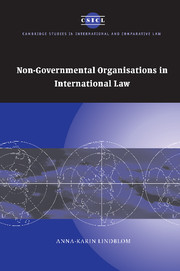Book contents
- Frontmatter
- Contents
- Acknowledgements
- List of abbreviations
- Part I Theoretical framework
- 1 The main issues and their context
- 2 Historical and conceptual background
- 3 International legal theory and non-state actors
- Part II Legal and empirical survey
- Part III Conclusion
- Bibliography
- Interviews
- Index
- CAMBRIDGE STUDIES IN INTERNATIONAL AND COMPARATIVE LAW
2 - Historical and conceptual background
Published online by Cambridge University Press: 12 August 2009
- Frontmatter
- Contents
- Acknowledgements
- List of abbreviations
- Part I Theoretical framework
- 1 The main issues and their context
- 2 Historical and conceptual background
- 3 International legal theory and non-state actors
- Part II Legal and empirical survey
- Part III Conclusion
- Bibliography
- Interviews
- Index
- CAMBRIDGE STUDIES IN INTERNATIONAL AND COMPARATIVE LAW
Summary
Introduction
The issue of legal subjects is at the core of any legal system. As for international law, its very name, as well as its traditional definition as ‘the body of rules which are legally binding on states in their intercourse with each other’ also determines the range of its actors. The circle seems to be closed for good. Even though it has long been accepted that international law is more complex than this definition suggests, the classical view lingers on and the concepts related to the issue of personality seem to be adapted to it. It is important to take a closer look at how the issue of the subjects of international law has traditionally been considered, for the argument that a new actor has acquired international legal status will inevitably be examined by reference to the traditional theory. My aim in this chapter is to describe this classical theory as well as some alternative views, how the concepts related to the issue of legal subjects have been used and which actors besides states have successively been accepted as legal subjects. This brief presentation will provide a background for chapter 3, which will deal with the modern theories of international law and outline my own methodology for the study.
The historical view of the subjects of international law
The horizontal and positivist interstate model of international law is closely connected to the nation-state system as it emerged after the Peace Treaty of Westphalia of 1648.
- Type
- Chapter
- Information
- Non-Governmental Organisations in International Law , pp. 53 - 78Publisher: Cambridge University PressPrint publication year: 2006

